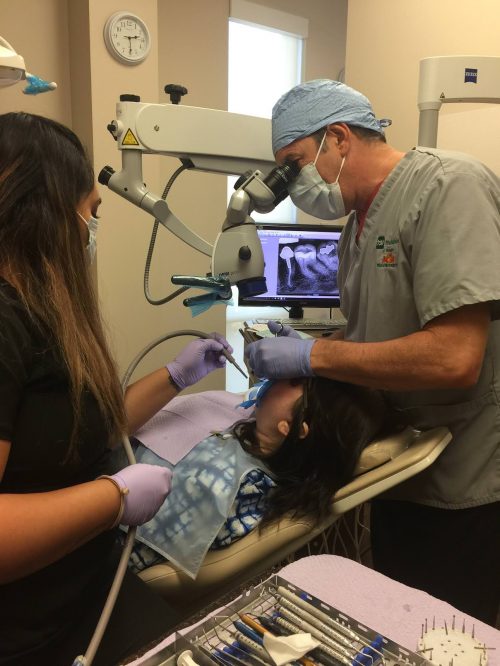- A comprehensive examination is performed to diagnose orofacial pain and pulpal injury and to determine if the tooth is a good candidate for endodontic therapy.
- The non-surgical treatment eliminates the diseased pulp. This injured pulp is removed and the root canal system is thoroughly cleaned and sealed.
- Under certain circumstances, microsurgery may be indicated. We are experts in performing this procedure, and utilize sophisticated equipment to ensure the best result.
As an endodontic patient, what should I expect?
Questions & Answers
What is a root canal?
A root canal is one of the most common dental procedures performed, well over 14 million every year. This simple treatment can save your natural teeth and prevent infection and the need for dental implants or bridges.
At the center of your tooth is the pulp. Pulp is a collection of blood vessels and nerves that helps to build the surrounding tooth. Infection of the pulp can be caused by trauma to the tooth, deep decay, cracks, and chips, or repeated dental procedures. Symptoms of the infection can be identified as visible injury or swelling of the tooth, sensitivity to temperature, or pain in the tooth and gums.
How is a root canal performed?
If you experience any of these symptoms, your dentist will most likely recommend non-surgical treatment to eliminate the diseased pulp, as commonly called “the nerve.” This injured pulp is removed and the root canal system is methodically shaped, cleaned, and sealed. This treatment involves local anesthesia and may be completed in one or more visits depending on the treatment required. Success for this type of treatment occurs in over 90% of cases.
If your tooth is not agreeable to endodontic treatment or the chance of success is unfavorable, you will be informed at the time of consultation or when a complication becomes evident during or after treatment. We use local anesthesia to eliminate discomfort. In addition, we will provide nitrous oxide analgesia if indicated (Fernandina office only). You will be able to drive home after your treatment, and you will be comfortable returning to your normal routine.
What happens after treatment?
When your root canal therapy has been completed, a record of your treatment will be sent to your general dentist. You should contact their office for a follow-up restoration within a few weeks of completion at our office.
Your general dentist will decide on what type of restoration is necessary to protect your tooth. It is rare for endodontic patients to experience complications after routine endodontic treatment or surgery. If a problem does occur, however, we are available at all times to respond. To prevent further decay, continue to practice appropriate oral-dental hygiene and visit your general dentist regularly.
How much will it cost?
The cost associated with this procedure varies depending on factors such as the severity of damage and which tooth is affected. In general, endodontic treatment is less expensive than a tooth extraction
Didn’t find the answer?
We are here to answer all your questions.

